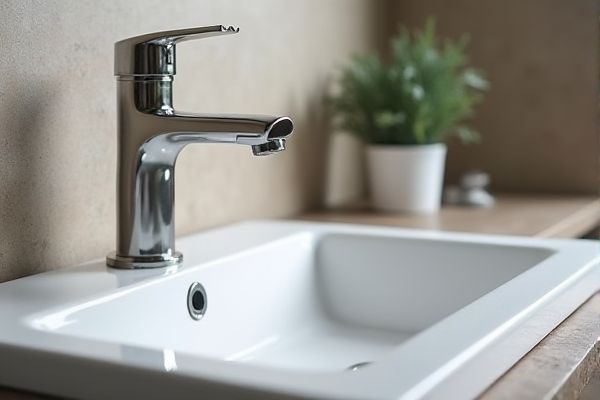
Vessel sink faucets are specifically designed to accommodate the raised height of vessel sinks, providing taller spouts and longer reach compared to standard faucets, which are typically suited for traditional sinks mounted flush with the countertop. Discover the key differences and advantages of each type to decide which faucet best suits Your bathroom style by reading the rest of the article.
Table of Comparison
| Feature | Vessel Sink Faucet | Standard Faucet |
|---|---|---|
| Design | Taller, designed for above-counter vessel sinks | Shorter, designed for standard sink installation |
| Installation Height | Higher spout for clearance above vessel sink rim | Lower spout, mounted close to sink surface |
| Water Flow Control | Usually single-handle, precise control for taller design | Single or double-handle, common in various style options |
| Compatibility | Specifically for vessel sinks requiring tall faucets | Compatible with standard drop-in or undermount sinks |
| Style Options | Modern, artistic, and statement-making faucets | Wide range including traditional, modern, and utilitarian styles |
| Cost | Generally higher due to specialized height and design | Typically more affordable and widely available |
| Maintenance | Easy to clean around tall faucet and vessel sink | Standard cleaning with less height to access |
Introduction to Vessel Sink Faucets vs Standard Faucets
Vessel sink faucets are specifically designed to accommodate vessel sinks, featuring taller spouts and increased height to provide adequate clearance above the sink rim, unlike standard faucets that suit drop-in or undermount sinks with shorter spouts. The elevated design of vessel faucets enhances water flow and usability, complementing the aesthetic appeal of vessel sinks. Standard faucets prioritize compactness and may lack the height needed for vessel sink installation, making them unsuitable for such applications.
Design Differences: Vessel Sink Faucets and Standard Faucets
Vessel sink faucets feature a taller spout and extended height to accommodate the elevated rim of vessel sinks, while standard faucets are shorter and designed for traditional drop-in or under-mount sinks. The unique design of vessel faucets often includes sleek, modern lines that complement the artistic appeal of vessel sinks, contrasting with the more compact and versatile design of standard faucets. Your choice should align with the sink style and desired aesthetic, ensuring proper water flow and ease of use.
Installation Requirements and Complexity
Vessel sink faucets require taller spouts and often need deck or wall mounting to accommodate the elevated sink design, making installation more complex than standard faucets. Standard faucets typically mount directly to the sink or countertop, allowing straightforward installation with common plumbing setups. Understanding your sink type and available mounting space is crucial to ensure your faucet installation proceeds smoothly.
Height and Spout Reach Considerations
Vessel sink faucets are typically taller than standard faucets to accommodate the height of vessel sinks, which sit above the countertop. Their extended spout reach ensures water flows directly into the sink bowl, preventing splashing and improving usability. Choosing the correct height and spout length for your faucet is essential to complement your sink design and optimize your bathroom's functionality.
Compatibility with Sink Types
Vessel sink faucets are specifically designed to be taller and accommodate vessel sinks that sit above the countertop, providing adequate clearance and optimal water flow. Standard faucets, generally shorter, are compatible with drop-in or undermount sinks that are installed flush with the countertop. Choosing the correct faucet type ensures proper fit and function, preventing splashing and enhancing overall bathroom aesthetics.
Water Flow and Pressure Comparison
Vessel sink faucets typically provide higher water flow and pressure to accommodate the elevated basin height, ensuring a steady and comfortable water stream. Standard faucets, designed for traditional sinks, often have lower spout heights and moderate flow rates suitable for everyday use. Your choice should consider the vessel faucet's ability to maintain adequate pressure without splashing, especially in taller setups.
Maintenance and Cleaning Needs
Vessel sink faucets typically require more frequent cleaning due to their higher exposure to water splashes and soap residue on the faucet base and handles. Standard faucets, mounted closer to the countertop, generally have fewer hard-to-reach areas, making maintenance and cleaning simpler and quicker. Choosing corrosion-resistant finishes like brushed nickel or stainless steel can reduce buildup and prolong the lifespan of either faucet type.
Style and Aesthetic Impact
Vessel sink faucets offer a tall, elegant design that complements the elevated bowl shape of vessel sinks, creating a striking focal point in modern or contemporary bathrooms. Standard faucets typically have a lower profile, blending seamlessly with traditional or undermount sinks for a subtle and classic look. Choosing the right faucet style enhances your bathroom's aesthetic harmony and highlights your sink's unique characteristics.
Cost and Budget Factors
Vessel sink faucets typically demand a higher budget due to their taller design and specialized installation requirements, often costing 20-30% more than standard faucets. Standard faucets provide a more affordable option, with a wide range of prices suitable for most budgets and easier installation that lowers overall labor costs. Considering your budget, a standard faucet offers better cost efficiency, while vessel sink faucets deliver unique style at a premium price point.
Which Faucet Type is Right for Your Bathroom?
Vessel sink faucets are typically taller and designed for vessel sinks sitting above the countertop, providing a stylish and modern look with easy water flow control, ideal for bathroom setups prioritizing design and space. Standard faucets, on the other hand, suit undermount or drop-in sinks with lower profiles, offering versatility and easier installation in traditional or compact bathrooms. Choosing the right faucet depends on your sink type, countertop height, and desired aesthetic, ensuring functionality and cohesive bathroom design.
 homyna.com
homyna.com